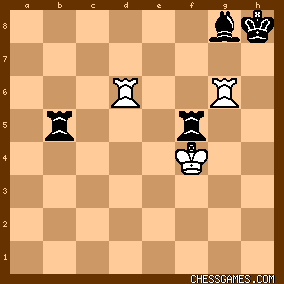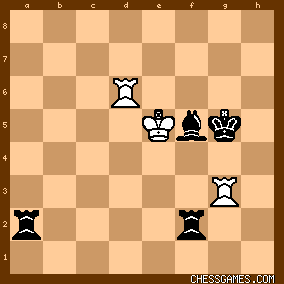| Oct-28-15 | | dumbgai: What a game! Props to both players, Giri for pushing with black and Ding for defending tenaciously. |
|
Oct-28-15
 | | WannaBe: Reminds me of this game:
Timman vs C Lutz, 1995
Black wants to win and white refuses to fold. |
|
Oct-28-15
 | | WannaBe: Fascinating, the side with the (extra) bishop, wins approx. 43%. Rest of the games are drawn. Endgame Explorer: RB vs R |
|
| Oct-28-15 | | cro777: Anish Giri: "Solid performance today. Restday well timed, if perhaps not entirely well deserved!" An interesting pawnless endgame arose after 66...Rhxf5+

click for larger viewThis position is theoretically won (Black mates in 67, including the capture inside 50 moves). After 67.Kg4 Black wins with 67...Bf7 or 67...Kh7. Other moves, including 67...Rf1? played by Giri lead to a draw. 66...Rhxf5+ 67.Kg4 Rf1

click for larger viewThis position is a theoretical draw after 68.Rb6! (the only move). Endgame tablebases are having great effect on the study of pawnless endgames. GM John Nunn wrote a book "Secrets of Pawnless Endings". In this book he extracted the most important information from the 5-man and 6-man tablebases and presented it in the form of guidelines and specific key positions in a way comprehensible to everage players. http://www.amazon.com/Secrets-Pawnl... |
|
| Oct-28-15 | | Marmot PFL: I figured that black should have a win, as the extra rook pair adds attacking chances, but this looks beyond human ability to calculate OTB. Later on Giri missed several other wins, but all of them looked extremely hard to find with little time to spare. |
|
| Oct-28-15 | | Gregor Samsa Mendel: Does the 50-move-rule still hold? If it does, white could have claimed a draw on move 166. |
|
| Oct-28-15 | | Karposian: <GSM> Yes. The rule is still in place. I actually find it quite strange that Ding didn't claim the draw before his 166th move. |
|
Oct-28-15
 | | FSR: Endgame Explorer: RR vs RRB reveals only two other games with two rooks and a bishop versus a rook. Like this game, both ultimately resolved into rook and bishop versus rook. |
|
| Oct-29-15 | | shivasuri4: 134...Kf4 (threatening mate) doesn't work either because of the surprise resource 135.Rg4+. |
|
Oct-29-15
 | | Check It Out: Holy moley! |
|
| Oct-29-15 | | Mehem: In the second half of the game Giri missed at least 2 opportunities to win by force. 1. on move 89.
89... Rf6+ 90.Kg5 Re5+ 91.Kg4 Kg7 92.Rh2 Re1 93.Kh4 Rh6+ 94.Kg3 Re3+

click for larger view
and White loses the rook on h2
2. on move 102
102... Rg2+ 103.Kf3 Kg6 104.Rh4 Kg5 105.Rh8 Rgf2+ 106.Ke4 Rfe2+ 107.Kf3 Bf7 108.Rg4+ Kf5 109.Rd4 Ke5 110.Rdd8 Bd5+

click for larger view
and White must give up its rook for a bishop. |
|
| Oct-29-15 | | Atking: <Gregor Samsa Mendel: Does the 50-move-rule still hold? If it does, white could have claimed a draw on move 166.> looking the live Ding Liren has even less time than Giri 3mn for 50s to Dig Liren with each move and add time but still... I suppose after 170 moves Ding Liren was pretty sure he had made 50 moves rules for the draw. It is incredible they can play such ending with few sec at hand to each move. |
|
| Oct-29-15 | | Sokrates: That has to be the longest GM game I have ever seen. 172 moves! Wow! |
|
| Oct-29-15 | | Jim Bartle: 106 moves after the last pawn was captured. |
|
| Oct-29-15 | | Karposian: <Jim Bartle: 106 moves after the last pawn was captured> Yes, but the last piece capture was at move 115. The fifty-move rule states that a player can claim a draw if no capture has been made and no pawn has been moved in the last fifty moves. So when Ding was to make his 116th move he could have claimed the draw, not before. But perhaps you know this all to well, and just wanted to point out how many moves were played after the last pawn was captured. And yes, 106 moves of pure piece play is of course rather incredible, <Jim>! |
|
| Oct-29-15 | | Jim Bartle: I wasn't saying they ignored the 50 rule. It's just a long, long time to play without pushing pawns. Most long games I've seen revolve around advancing or capturing pawns. Here there was none of that. |
|
| Oct-30-15 | | tim butler: Are they still playing? |
|
Apr-18-18
 | | offramp: There is only one ending more tedious than R+B v R, and that is Q+P v Q. YAAAAAWWWWWN!😫😫😫😫😫😫 |
|
| May-12-20 | | g15713: E. 1.0
Black to move. Check. Last: 108.Rg3+

click for larger viewAfter an up-and-down battle Black was still winning with either:
108...Kh4 or Kh5
Syzygy 'https://syzygy-tables.info/?fen=8/8... However, even after 108...Kh4 with good defense White could eventually claim a draw with the 50-move-rule since the last piece capture was at move 66. Chess user <Karposian> <"The fifty-move rule states that a player can claim a draw if no capture has been made and no pawn has been moved in the last fifty moves."> Instead Black played 108...Bg4?
which forced Black into exchanging a pair of rooks after 109. Rd4! Game continued:
108...Bg4 109. Rd4 Ra5+ 110. Kd6 Ra6+ 111. Kc5 Rf5+
112. Kb4 Rb6+ 113. Kc4 Rc6+ 114. Kb4 Rf4 115. Rxf4 Kxf4 E. 1.1
Leads to a theoretical draw of Rook + Bishop versus Rook ending 
click for larger view'https://syzygy-tables.info/?fen=8%2... |
|
May-25-24
 | | An Englishman: Good Evening: Makes me wonder about a law of chess physics I proposed decades ago--"All chess players below 2200 Elo will study the R & B v. R endgame, but only *after* they have lost the only rated game where they shall ever encounter it." Fellow chess physicists, does this sound like a reasonable hypothesis? |
|
| May-25-24 | | Cecco: According to this engine, black could gain an advantage of 6.18 with 45. ... Kf8. Afterwards he plays 48. ... Kf8, with parity, while an advantage of 3.67 is evaluated for the alternative 48. ... Bg2. |
|
| May-25-24 | | NimzoCharlie: What is the point of 14. Ra4? And why can’t Black take the d-pawn? |
|
| May-25-24 | | NimzoCharlie: By which I mean 14 … dc 15. cd Bxd4? |
|
May-25-24
 | | beatgiant: <NimzoCharlie> Your line looks playable, but after 14...dxc4 15. bxc4 Bxd4 16. Nxd4 Rxd4 17. Rb4 I think White will soon either win back the pawn or get enough compensation with his piece activity. |
|





